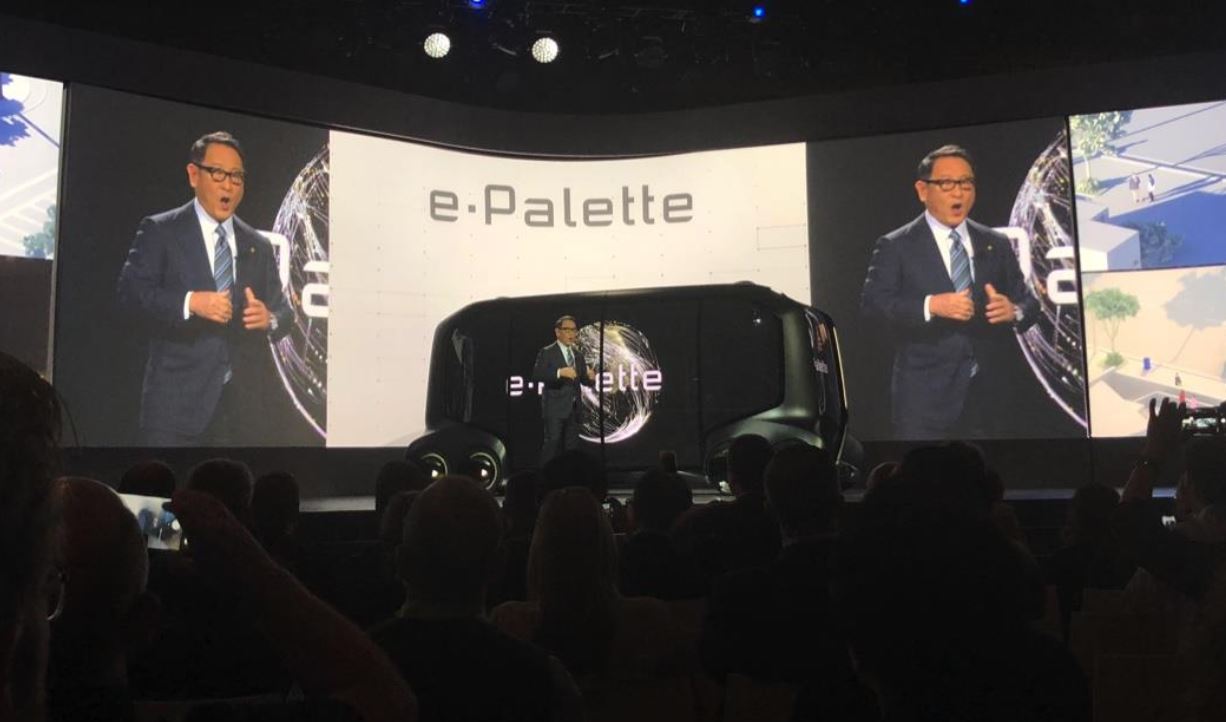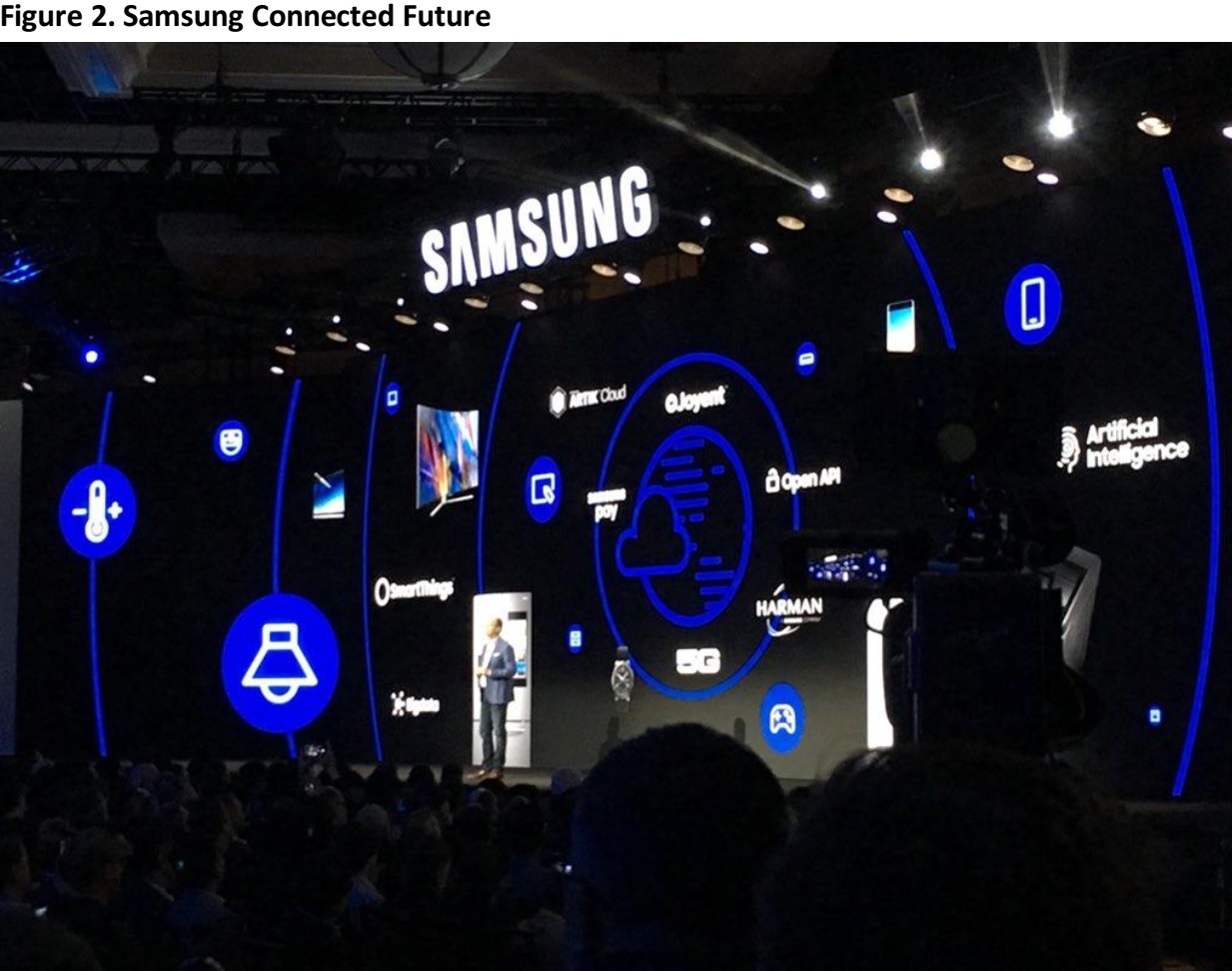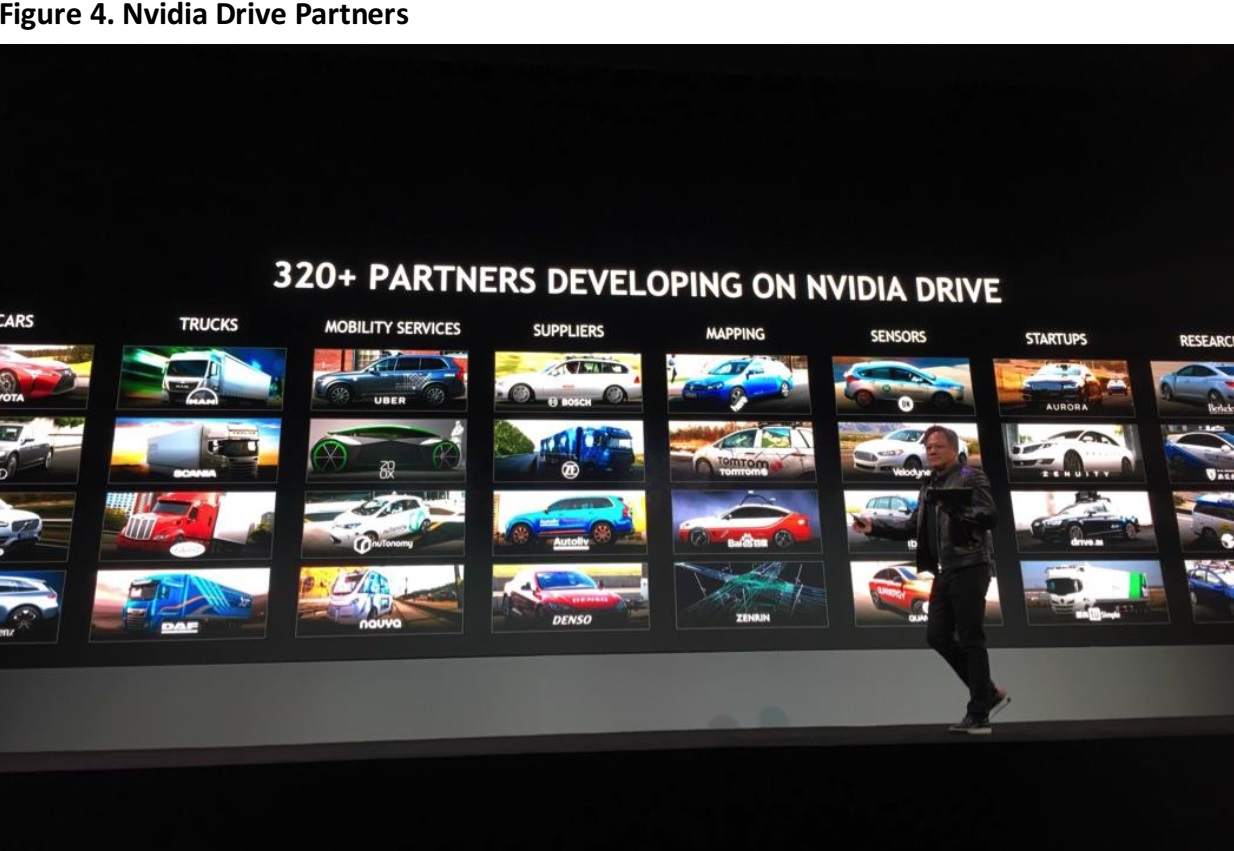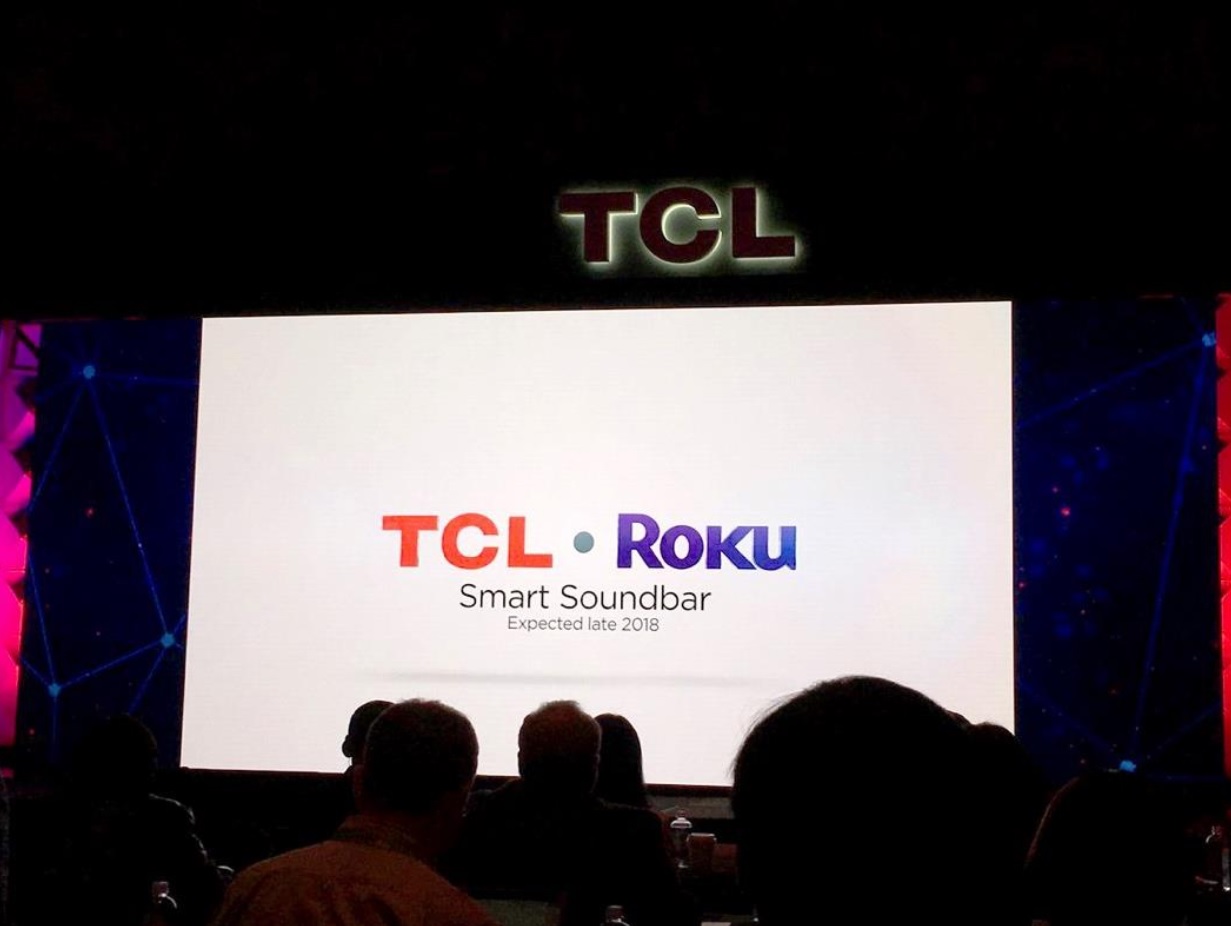1) Toyota Unveils On-Demand Autonomous Concept Vehicle
Toyota President Akio Toyoda announced a new on-demand autonomous vehicle to support a range of business applications. The company envisions autonomous mobility services as a core part of its overall business. “E-Palette is one example of Toyota’s vision for autonomous business application,” said Toyoda.
The e-Palette is a fully automated and electric vehicle powered by Toyota’s autonomous technology and designed to support a range of uses, including ride sharing, delivery and retail. Toyoda envisions these boxy, multifunctional on-demand vehicles as serving a variety of functions, from mobility services such as ride-sharing, serving as a mobile office, retail experiences, meal deliveries and more. “Just think how good e-Palette would be at Burning Man,” said Toyoda

Source: FGRT
Toyota announced that it has partnered with several major companies on this project, including Amazon, Didi, Pizza Hut, Mazda and Uber. The Japanese automaker says it hopes to debut its e-Palette at the 2020 Olympics in Tokyo.
2) Panasonic Is Bringing Google Assistant and Amazon Alexa to the Future of In-Car Infotainment
Panasonic is celebrating its 100th anniversary, initially with consumer electronic products and recently with partnerships and disruptive technologies. Tom Gebhardt, North American Chairman and CEO, outlined the Digital Solution Center, which aims to combine the physical and digital worlds. Focus areas include the mobile and connected world, sustainable energy usage, integrated supply chains, immersive entertainment and living spaces in our homes.
The company today announced the third generation of airline satellite connection technology, with 20x the bandwidth of previous generations, even video streaming in the sky. The company is partnering with leading automakers on infotainment systems (Panasonic is #1) on cloud-based services.
Panasonic is partnering with Amazon to give in-car Alexa capabilities. The initiative, dubbed Alexa Onboard, works with Panasonic’s upgraded Skip Generation In-Vehicle Infotainment, which now gives the system Google Assistant capability. Users will be able to ask Alexa to change the temperature in their car, ask what is coming up on their calendar and control in-car functions such as audio and ventilation systems, navigation functions and more. Panasonic is also partnering with Amazon on smart highways, assisted and autonomous driving technologies, sustainable energy, transforming retail and restaurants, robotics and immersive entertainment.
Gebhardt highlighted several other initiatives and partnerships—such as one with the city of Colorado Springs, Colorado—to work on smart cities projects, including a high-tech US Olympics museum. Gebhardt also discussed partnering with Tesla on building better batteries for electric vehicles.
Panasonic also announced a new large OLED TV with industry-leading color accuracy, 4K Ultra HD Blu-Ray players, smart speakers, home monitoring systems, new Technics audio products, cameras and HomeX.
3) Samsung Is Building a Connected Future; Accelerating IoT Adoption Across all Samsung Devices
Samsung holds claim to 20% of the global smartphone market, being the global brand leader for 12 consecutive years, as well as being the global leader of the refrigerator market, in addition to holding number-one positions in TVs and appliances.
At CES, Samsung highlighted its ongoing commitment to IoT technologies. In 2017, the company spent more than $14 billion on research and development (R&D) and more in capital spending to develop technologies, as well as on acquisitions. Acquisitions include SamsungPay, SmartThings and Harman, as well as investments in numerous startups.

Source: FGRT
The company aims to make consumers’ lives smarter and better. In IoT, SmartThings has evolved into one of the largest open platforms; 90% of the company’s TVs, appliances, phones and tablets are now IoT ready. Samsung’s IoT strategy aims to include seamless connectivity and intelligence. The SmartThings app will be used to control appliances early this year via SmartThings Cloud. By 2020, all Samsung devices will be IoT ready and intelligent. Samsung’s digital assistant, Bixby, will appear on select Smart TVs and its new Family Hub refrigerator in 2018.
The company also announced its new 4K TV called “The Wall.” The Wall measures 146 inches and uses micro-LED technology to produce its picture. The wall has a bezel-less design that Samsung describes as “module-based.” According to the company, this approach will ultimately allow customers to create a TV sized just for their needs. For now, The Wall is a concept product, but Samsung said to expect more details at “a global launch” sometime this spring. Samsung also showed Flip, a portable digital whiteboard.
4) Bosch’s Smart Cities Solutions Enhance Mobility, Minimize Energy and Manage Air Quality
Bosch management presented on smart cities, which enhance mobility, minimize the use of energy, incorporate smart homes and buildings, and offer security to help fight crime. The smart cities market is booming, on track to reach $800 billion by 2020. Las Vegas recently announced a $500 million investment over the next seven years.
Bosch highlighted IoT innovations in sensors, AI and big data. As the world becomes increasingly urbanized, this puts pressure on energy networks and the environment. Bosch is participating in 14 beacon projects around the world. The company’s product portfolio includes mobility, energy, buildings, industrial technology and sensors.
Bosch has 4,000 engineers working exclusively on IoT. The company is focusing on 3S: sensors, software and services to enable smart cities. Challenges for smart city initiatives include air quality, urban mobility, energy and safety.
5) BrainCo Showcases Attention-Measuring Wearable
BrainCo is a company incubated by Harvard’s iLab. Brain-machine interfaces (BMI) are the next big thing. BMIs can look in (‘read’ the mind) or reach out (control external smart devices) to expand mental capacity and extend human reach.
The attention-measuring BrainCo Focus is a wearable (a headband) that offers interesting applications in the education space. Teachers can observe their students’ attention levels in the classroom in order to develop new teaching methods that optimize student attention and improve academic performance and learning efficiency.
Announced at CES, Focus Family is an app that provides feedback on brainwave trends while the wearer is studying or concentrating. BMIs can also be used to control prosthetic limbs, enabling a nonintrusive AI-powered prosthetic hand for less than $5,000, compared to existing solutions that cost more than $60,000.
The company showed a clip from a Chinese TV show, in which an amputee used a BMI-powered prosthetic arm to paint Chinese characters after just 10 minutes of practice. The company demonstrated a BMI-powered robotic arm and Sawyer industrial robot arm at the session, and is also demonstrating connection to the Alexa intelligent home assistant.

Source: Fergus Halliday/IDG
6) Hisense Unveils New Line of Ultra HD TVs with Special Features Targeting the Upcoming FIFA World Cup Tournament
Hisense claims 60% of the market for 85-inch and above laser TVs. The market is trending towards larger TVs and the 75-inch and above market continues to expand. There are now several companies entering the market. Hisense is demonstrating 80-, 88- and 100-inch TVs this year, and will continue to invest in laser TVs. In 2017, Hisense launched a 100-inch laser TV, receiving positive comments from customers. The group recorded $17 billion in sales last year, including $1 billion in the US.
In 2018, Hisense is a sponsor of US soccer and of the FIFA World Cup tournament in Russia. The company is introducing two new TVs for this year’s World Cup: the U7 and U9 ULED TVs and LED backlit LCD TVs. The TVs will also feature a World Cup app with exclusive access to live feeds, viewing angles and other programming, streamed in high dynamic range (HDR). All of the company’s 4K TVs will gain access to a Phenoms documentary on the World Cup. In addition, new Hisense TVs will have Amazon’s Alexa voice services built in.
The company is offering a lineup including a 55-inch HDR/HDR10 TV for $699 this year. Hisense claims to be one of three companies that design their smart TV platforms in-house. Its laser TV includes three key technologies: a proprietary last light engine, a Texas Instruments digital light processing (DLP) chip and Harman-Kardon sound. Hisense also demonstrated a 150-inch laser TV.
7) Solace Lifesciences Showcases All-Natural Sleep Solutions and Stress Management Technology
Solace Lifesciences, the maker of NuCalm—a patented, all-natural, and clinically proven system that transitions the body into deep relaxation within minutes for optimal restoration—uses advanced neuroscience technology to combat stress and sleep issues. Stress is one of the most profound problems facing humanity. Negative consequences of not managing stress lead to disease, and stress impacts our sleep. The sleep specialist doctor who presented has been working with Solace Lifesciences for the past five years. Alcohol eases sleep but prevents the restful phases.
NuCalm was invented 20 years ago and has a patent to manage the autonomic nervous system. NuCalm uses biochemistry and physics to manage the body and keep it in balance. It uses an amino acid to slow down adrenaline, in addition to a visor stimulation device and software. Alpha brainwaves are consistent with relaxation; theta represents the healing zone for humans. NuCalm overrides the brain and presents it with a pattern that creates relaxation. Ambien—a sedative primarily used for the treatment of insomnia—is the #1 sleep in aid in the world, and it affects sleep receptors.
NuCalm is a non-pharmacological solution. The NuCalm audio track also offers performance-related benefits for sports. At CES, the company is launching a consumer version of its solution, to be priced under $1,000.
8) Qualcomm Makes Several Announcements Regarding Wireless Communication Solutions, Audio Products and Automotive Infotainment Systems
Qualcomm made a slew of announcements at this year’s CES regarding wireless communications, audio products including smart speakers and wireless earbuds, and automotive infotainment systems, including:
- Radio frequency front-end (RFFE) design wins with a several equipment manufacturers (OEM), including Google, HTC, LG, Samsung and Sony Mobile.
- Plans to offer a smart speaker development kit based on its Smart Audio Platform, which is engineered to aid developers and audio manufacturers in the development of smart speaker products at a variety of price points. It will be available in the first half of 2018.
- A new low-power Bluetooth system-on-a-chip (SoC) series for the development of a new generation of compact, full-featured wireless earbuds, wearables and headsets.
- That its solutions for integrated infotainment and digital cluster systems have been selected for upcoming electric vehicles from BYD.
- That its Smart Audio Platform would support Android Things, Google Assistant, Google Cast for audio and other Google services; this platform will also support Microsoft’s Cortana intelligent digital assistant.
The company made other announcements regarding its mesh platform for smart homes, an audio platform qualified for Amazon’s Alexa Voice Service platform, personalization, infotainment and telematics systems for the 2018 Honda Accord and a high-definition Bluetooth wireless audio codec, called aptX™ HD.
9) Nvidia Advances NVIDIA DRIVE: Demonstrates Autonomous Driving Capability and Announces Partnerships with Uber for Driverless Cars and with Volkswagen on Intelligent Vehicles
Nvidia held a two-hour, exclusive press conference on the opening night of CES. Founder and CEO Jensen Huang described how GPU computing—the use of a graphics processing unit with a CPU to accelerate deep learning, analytics and engineering applications—is the primary business driver for the company, and its platforms are built on its computing power. Huang described Nvidia’s three core business areas: gaming, deep learning and autonomous driving.
Huang predicted that in the future, all cars will be autonomous. He said “We have to turn the car into AI.” Over 320 partners are using Nvidia Drive, which includes cars, trucks, sensors, mobility services, mapping, startups and research.

Source: FGRT
Nvidia announced two new partnerships: with Uber and Volkswagen.
The goal of the Uber partnership is to have all driverless cars. At the press conference, Huang showed an in-car video of a Nvidia employee test driving its new autonomous driving capability using no hands. The car made over 20 turns, through traffic, for over eight minutes.
Nvidia is partnering with Volkswagen to use NVIDIA DRIVE IX platform in a new generation of intelligent Volkswagen vehicles.
Volkswagen CEO Herbert Diess presented the VW MicroBus in a reimagined, modern day form. Diess described how the companies are partnering and infusing AI technology in the cockpit for self-driving, using rotating seats for a “living room style.” The NVIDIA DRIVE IX Intelligent Experience platform is a software development kit for creating AI-enabled applications such as facial recognition for automatically unlocking and opening the car, surround perception to alert the driver to road hazards, gesture recognition for user controls and natural language for understanding.
10) TCL Announces Partnership with Roku that Leverages Voice Technology for TV Content

Source: FGRT





